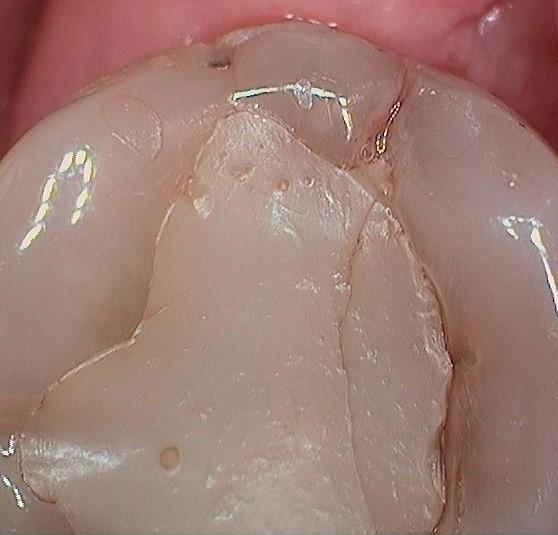
As Dentists in Woodland Hills and Manhattan Beach, California we are commonly asked the question, "I see cracks and fractures in my teeth. Should I be worried?"
When patients are asking this question they are generally seeing cracks or small fractures (AKA: craze lines) that they see on their front teeth as you see on the first image. It is difficult or pretty much impossible for the patient to see a crack on the back of their molar in a mirror. It is often difficult even for a dentist to see these fractures without proper lighting and magnification.

As you can see from the picture of the craze lines (tooth #1) that these are very faint vertical white lines. There is no decay or cavity in these cracks and no treatment is required in a situation like this.

On the other hand there are some cracks that are very serious and if action is not taken to correct the situation the tooth is often lost.
Premolars (tooth #2) that have a crack running through the tooth from front to back like on the image collage that you see are often extracted and replaced by implants. Premolars can have multiple roots with one root on the outside and one root on the inside. The crack usually weakens the tooth and it ends up fracturing down the root below the gum. Once this happens there is no way to repair the tooth and it needs to be pulled. These pictures were all taken at the same time. The first image (upper lerft) shows as the patient presented. The second image (upper right) shows the tooth as a gentle stream of air was blown on it. You can see the two pieces separate. The bottom right image shows the tooth with the fractured piece removed.


The other tooth that often is prone to fracture is a lower molar. Both first and second lower molars are prone to fracture. The usual locations of the fracture are either the inside of the tooth (tooth #3) or the back of the tooth (tooth #4). You can see that in both of these fractures there is discoloration around the crack. This is very different from the craze lines. In these deeper fractures the tooth actually opens as it flexes during function and bacteria get inside the tooth causing decay or a cavity. To understand why these cracks are dangerous we can use the analogy of a cracked windshield. Initially, the damage to the windshield may be small. There may not even be a crack, it may just be a chip. Over time as stresses are continually applied to the material the damage can spread. Once you have a crack that starts it quickly grows larger over time. It works the same way in teeth. Below the gum is the root of the tooth with ligaments around it that hold the tooth in the socket. If this crack continues to grow and extends onto the root, there is no way to repair the crack and the only available treatment is extraction.

Treatment or Solution:
So what can you do to protect your tooth and prevent and extraction. Watching these fractures doesn't work. You can watch them get larger and more serious. Early treatment for these large fractures is key for survival of the tooth. If it is caught in time, a crown that covers and protects the entire tooth. For tooth #4, the second image shows what the tooth looks like after the filling and decay was removed and the tooth was prepared for the crown. You can see that the crack runs through the entire length of the tooth. The nerve is in the center of the tooth, so the closer the crack is to the center of the tooth the higher the chance that the tooth will need a root canal in the future. What increases the risk for unrepairable damage is when the crack is on the outside of the tooth and continues down below the gum as in the next photo. In these situations we try to prep the tooth as deep as possible to get rid of the crack. If we can get rid of the crack externally we know that it stops where we stopped our preparation of the tooth. As you can see in this photo even going as deep as possible you can still see the crack on the outside.

I hope this gives you some more information so you understand the process when we decide to crown one of these teeth. If you have been feeling any sensitivity or pain on chewing and biting this can indicate that there may be a crack in one of your teeth. Please call one of our locations today and book your appointment today!